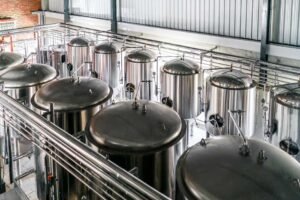When it comes to selecting the right material for a fabrication project, steel is often the go-to choice. But not all steel is created equal. At Brandywine Valley Fabricators, we work with a variety of materials to deliver custom solutions that meet our clients’ exact needs—and two of the most commonly compared options are stainless steel fabrication and mild steel fabrication.
While both have their advantages, they serve different purposes depending on the application. In this blog, we’ll break down the key differences between stainless steel and mild steel, and explain when and why stainless steel fabrication may be the superior option.
What Is Mild Steel? Mild steel, also known as low-carbon steel, contains a small amount of carbon (typically 0.05% to 0.25%) and no significant alloying elements. It’s widely used for general fabrication due to its low cost, ease of machining, and good weldability.
What Is Stainless Steel? Stainless steel is a corrosion-resistant alloy of iron that contains a minimum of 10.5% chromium. It’s often alloyed with other elements like nickel and molybdenum to enhance its strength, durability, and resistance to oxidation and staining.
Key Differences Between Stainless and Mild Steel:
1. Corrosion Resistance
- Stainless Steel: Highly resistant to rust, corrosion, and chemical exposure. Ideal for outdoor, marine, food-grade, and medical applications.
- Mild Steel: Susceptible to rust and corrosion unless treated or coated. Not suitable for environments with high moisture or corrosive exposure.
2. Strength and Durability
- Stainless Steel: Generally stronger and more durable than mild steel. Maintains integrity in high-stress and high-heat environments.
- Mild Steel: Adequate strength for many applications but may require reinforcement or protective coatings in demanding conditions.
3. Appearance
- Stainless Steel: Shiny, polished finish that holds aesthetic appeal for architectural and commercial uses.
- Mild Steel: Duller finish; typically painted or powder-coated to prevent rust.
4. Cost
- Stainless Steel: More expensive due to its alloy content and resistance properties.
- Mild Steel: Cost-effective for budget-sensitive projects and suitable for indoor or low-risk applications.
5. Fabrication and Weldability
- Stainless Steel: Requires more precision and expertise during fabrication due to its hardness and thermal properties.
- Mild Steel: Easier to weld, cut, and form, making it a popular choice for basic fabrication jobs.
When Should You Choose Stainless Steel Fabrication? At Brandywine Valley Fabricators, we recommend stainless steel fabrication for projects where:
- Corrosion resistance is critical (e.g., food processing, outdoor structures, chemical handling)
- Aesthetic appeal matters (e.g., architectural features, commercial kitchens)
- Long-term durability and minimal maintenance are desired
When Is Mild Steel a Better Fit? Mild steel is ideal for:
- Indoor structural components
- Budget-conscious fabrication projects
- Temporary or low-stress applications
Conclusion: Material Choice Matters Choosing between stainless steel fabrication and mild steel depends on your project’s requirements, environment, and budget. While mild steel has its place in general construction and basic applications, stainless steel offers unmatched durability, corrosion resistance, and longevity.
At Brandywine Valley Fabricators, we help our clients choose the right material for their goals—and deliver expertly crafted components, no matter the spec. Contact us today to discuss your next project and find out how our stainless steel fabrication services can elevate your results.








